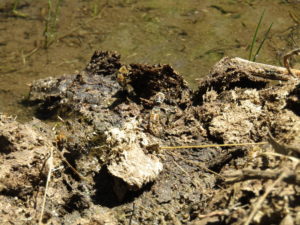Sit back, close your eyes and picture a butterfly.
What did you see? Here's an image... It's a warm June day, the songbirds are singing, grass blades are blowing in a light breeze, and you see a beautiful butterfly land on a vibrant flower. Nice, right? When asked to picture a butterfly in their head most people would probably see one flying around in their garden or landing on a wildflower out in a forest meadow while on a hike (like the butterflies pictured right and below). Which is sensible. Butterflies are nectarivores, so they like flowers. They consume nectar produced by flowering plants. It's a mutualistic relationship between the plant and the butterfly. The plant produces nectar to attract the butterfly (and other nectarivores), the butterfly gets a yummy sugar-rich meal, and in return the butterfly leaves the flower with the the flower's pollen all over itself and flies to another flower or plant passing along the plants genetic material. Nature's so cool.

Swallowtail visiting Anderson thistle. Photo Meg L.

Skipper visiting mule's ears. Photo Meg L.

Swallowtail visiting larkspur. Photo by Megan F.
It's curious then to see a beautiful butterfly in the middle of a trail, along a stream, or even in the middle of a road sitting in mud.
The official terminology for this behavior is mud-puddling, or just puddling. And this is not equivalent to a person having a spa day and taking a mud bath. No, this is an essential behavior displayed by many different nectarivorous species. The problem with nectar is that it is dominantly composed of sugar, depriving nectarivores of other nutrients. Mud-puddling is the act of sucking up moist substances from mud, rotting plant matter, carrion, or animal dung, and obtaining various nutrients like salts, proteins and nitrogen from these substances.

Swallowtails mud-puddling. Photo by Meg L.
However, in many mud-puddling species only males partake in this "dirty" act. It is thought that mud-puddling males pass along salts and mud-derived nutrients to females during reproduction. Recent research has even concluded that for some species of butterflies (in this study they looked at pipevine swallowtail, Battus philenor), male butterflies that consume salts have greater mating success than males that don't consume salts (Mitra et al. 2016). The researchers found that male pipevine swallowtails that consumed salts courted more vigorously and had significantly different courtship displays than males that did not consume salts, which the authors believe is possibly a direct cue to females of the superiority of the salt-consuming males. This research suggests that salts, and the act of mud-puddling, increases reproductive success, at least for pipevine swallowtail males.
Thus far I have given swallowtails a bit too much of the spotlight. Other butterfly species partake in the mud-puddling, including ladys, admirals, and blues as pictured below.

American lady mud-puddling in mud and cow dung. Photo Meg L.

Lorquin's admiral mud-puddling in mud. Photo Meg L.

Blue mud-puddling in cow dung. Photo Meg L.
Even other insects partake in mud-puddling, like the bees pictured right. Other insects mud-puddle for the same reasons butterflies do, to acquire nutrients lacking in their other food sources.

Bees mud-puddling in cow manure. Photo Meg L.
Now I bet the next time you're asked to sit back with eyes closed and picture a butterfly (which is probably not that often to be honest), you just might picture a butterfly acquiring some much needed salts in a mound of mud. 🙂

